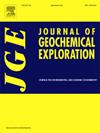Improving the performance of contamination indices by accounting for local baselines in stream sediment: A sample catchment basin approach
IF 3.3
2区 地球科学
Q1 GEOCHEMISTRY & GEOPHYSICS
引用次数: 0
Abstract
Geochemical prospecting serves as a fundamental approach for examining the influence of geological settings on stream sediment composition and identifying natural or anthropogenic geochemical anomalies within a river catchment. Various indices have been developed to assess sediment quality and environmental status, typically based on ratios between observed element concentrations and reference values representing undisturbed conditions. However, these reference values often fail to account for the influence of river dynamics on sediment variability, potentially compromising the reliability of contamination assessments. Since the chemical composition of stream sediments reflects the cumulative influence of their upstream catchment basins, the dilution correction method has been extensively employed in previous studies to mitigate the dilution effects caused by fluvial processes. To address this, the present study evaluates whether local geochemical baselines can improve the performance of contamination indices. The Sarno River basin, heavily impacted by urban and industrial activities, was selected as a case study. Ninety-six sediment samples were analysed using geomorphological and hydrological parameters to define each Sample Catchment Basin (SCB). Baseline concentrations of Cd, Cr, Cu, Hg, Ni, Pb, Sb, and Zn were then estimated by calculating the weighted average element content based on lithological unit proportions within each SCB. Then, contamination indices were computed using both uncorrected (raw) and SCB-corrected baselines and spatially mapped. The use of SCB-based reference values led to a 23 % increase in the detection of high-impact sites using the Enrichment Factor and a 366 % increase using the Contamination Factor, revealing a substantial underestimation of contamination in the raw approach. Comparative analysis also showed a more balanced distribution of element contributions in the corrected indices, indicating improved representativeness of multi-element contamination. These results highlight the advantages of incorporating local baseline variability into geochemical evaluations, providing a more accurate and spatially consistent framework for environmental risk assessment in fluvial systems.
通过计算河流沉积物的当地基线来改善污染指数的性能:一个样本集水区方法
地球化学勘探是研究地质环境对河流沉积物组成的影响和识别河流集水区内自然或人为地球化学异常的基本方法。已经开发了各种指数来评估沉积物质量和环境状况,通常基于观察到的元素浓度与代表未受干扰条件的参考值之间的比率。然而,这些参考值往往不能解释河流动力对沉积物变异性的影响,从而可能损害污染评估的可靠性。由于河流沉积物的化学成分反映了其上游流域的累积影响,因此稀释校正方法在以往的研究中被广泛采用,以减轻河流过程引起的稀释效应。为了解决这一问题,本研究评估了局部地球化学基线是否可以改善污染指标的性能。受城市和工业活动严重影响的萨尔诺河流域被选为案例研究。使用地貌和水文参数对96个沉积物样本进行了分析,以确定每个样本集水区(SCB)。然后通过计算每个SCB内岩性单位比例的加权平均元素含量来估计Cd、Cr、Cu、Hg、Ni、Pb、Sb和Zn的基线浓度。然后,使用未经校正的(原始)和scb校正的基线和空间映射计算污染指数。使用基于scb的参考值导致使用富集因子对高影响地点的检测增加了23%,使用污染因子增加了366%,揭示了原始方法中对污染的严重低估。对比分析还表明,修正后的指标中元素贡献分布更为均衡,表明多元素污染的代表性得到了提高。这些结果突出了将当地基线变异性纳入地球化学评价的优势,为河流系统的环境风险评估提供了更准确和空间一致的框架。
本文章由计算机程序翻译,如有差异,请以英文原文为准。
求助全文
约1分钟内获得全文
求助全文
来源期刊

Journal of Geochemical Exploration
地学-地球化学与地球物理
CiteScore
7.40
自引率
7.70%
发文量
148
审稿时长
8.1 months
期刊介绍:
Journal of Geochemical Exploration is mostly dedicated to publication of original studies in exploration and environmental geochemistry and related topics.
Contributions considered of prevalent interest for the journal include researches based on the application of innovative methods to:
define the genesis and the evolution of mineral deposits including transfer of elements in large-scale mineralized areas.
analyze complex systems at the boundaries between bio-geochemistry, metal transport and mineral accumulation.
evaluate effects of historical mining activities on the surface environment.
trace pollutant sources and define their fate and transport models in the near-surface and surface environments involving solid, fluid and aerial matrices.
assess and quantify natural and technogenic radioactivity in the environment.
determine geochemical anomalies and set baseline reference values using compositional data analysis, multivariate statistics and geo-spatial analysis.
assess the impacts of anthropogenic contamination on ecosystems and human health at local and regional scale to prioritize and classify risks through deterministic and stochastic approaches.
Papers dedicated to the presentation of newly developed methods in analytical geochemistry to be applied in the field or in laboratory are also within the topics of interest for the journal.
 求助内容:
求助内容: 应助结果提醒方式:
应助结果提醒方式:


